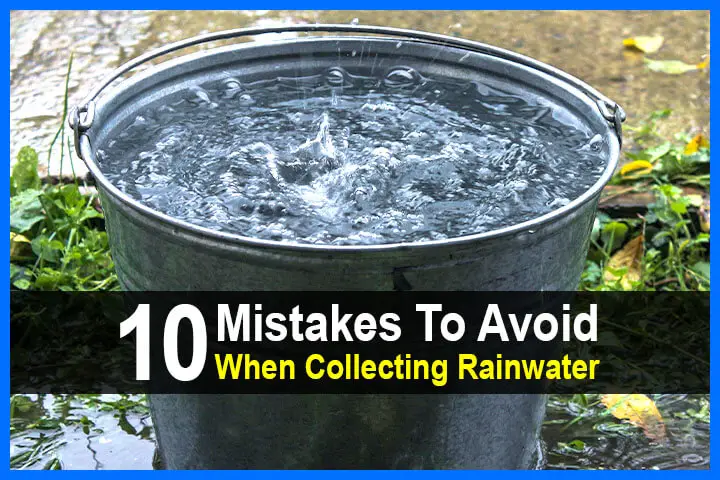Estimated reading time: 7 minutes
Collecting rainwater for drinking purposes may seem simple enough, but there are many ways it can go wrong – some of which can actually be quite dangerous.
If you would like to start collecting rainwater in a way that is both safe and effective, make sure that you avoid these common rainwater collection mistakes.
Want to save this post for later? Click Here to Pin It On Pinterest!
Mistake #1: Using the Wrong Container
While there are plenty of containers that are capable of holding water, not all of them are suitable for collecting and storing drinking water. Some containers may leach dangerous chemicals into your water, while others are not opaque enough to block out the sunlight – which could encourage algae growth.
Dark-colored plastic barrels are ideal for collecting rainwater, but many other containers will work so long as they are large enough, opaque enough, and not coated with any chemicals that could leach into your water.
Mistake #2: Forgetting to Make Sure it is Legal in Your Area
Believe it or not, collecting rainwater is not completely legal in all fifty states. Several states have decided that rainwater is community property and not something that can be taken by rainwater collectors.
In other states, collecting rainwater is legal, but there are certain restrictions. In Kansas, for example, you may be required to apply for a permit before you are able to collect rainwater.
If you want to make sure you stay on the right side of the law, check your state’s laws and regulations regarding the collection of rainwater before you begin. Read this article to find out of collecting rainwater is legal in your state.
Mistake #3: Not Collecting Enough
Most people don’t realize how much water they use until it becomes scarce. It takes a lot of water to survive, even if you start skipping showers and laundry day.
If you are building a rainwater collection system for the purpose of disaster survival, be sure to calculate how much water you are going to need and how much your system is going to collect.
If you don’t, you may end up with a system that does not collect nearly enough water for you to live on. The more that you are able to collect, the better – in a disaster scenario, there is certainly no such thing as having too much drinkable water.
Mistake #4: Not Letting the Rain Rinse Your Roof Before Collecting It
When the rain starts to pour, many people start collecting it right away. However, it is essential to let the rain rinse your roof for at least ten minutes before you start collecting it.
The reasons for this are obvious when you think about it. Dirt, plant material, feces, and all kinds of other debris gather on your roof, which means it will gather in your water too if you don’t give the rain a chance to wash it away.
Mistake #5: Not Purifying Your Rainwater Before You Drink it
In theory, rainwater is completely pure and safe to drink. However, that assumes it doesn’t come in contact with anything before it lands in your collection barrel. In reality, your rainwater may be coming into contact with all kinds of unsavory things on its way down your roof and into your barrel.
The chances of getting sick from drinking rainwater that you collect may be slim – much slimmer than drinking water from an unknown stream or pond – but there is still a chance.
To avoid this risk, all you need to do is purify your water supply. It’s a simple precaution that could save you from a lot of misery and one that may even save your life.
Mistake #6: Purchasing a Rainwater Collection System
Unless you have loads of money to throw away, purchasing a pre-made rainwater collection system is a waste. Making your own rainwater collection system is fairly simple, and the instructions for doing so as well as the supplies you will need are both cheap (if not free) and readily available.
Pre-made rainwater collection systems, meanwhile, can cost upwards of $1000. There’s simply no real reason to spend that kind of money for something you can do yourself in a day’s time.
In fact, with a little time spent searching, you can likely find all of the supplies you need – including collection barrels – for little to no cost at all, and building your collection system once you have the right supplies is a simple project.
Mistake #7: Not Using a Collection Screen
If you plan to use the rainwater that you collect for any purpose other than watering your garden, a collection screen is essential. Simply putting a fine, wire mesh screen over your collection barrel will allow the water to pass through while blocking out unwanted debris such as leaves, dirt, bird poop, and more.
If these things don’t sound very appetizing, be sure to put a screen over your collection barrel. In addition to a mesh screen, you can also use fabric sheets or even a layer of cooking oil to filter the water that goes into your barrel.
Mistake #8: Not Setting up a System for Getting Your Water Out
Sure, it’s possible to dip water out of a collection barrel using a cup or other small container, but there are more efficient ways to access the water you collect. Installing a spigot on your collection barrel is something that doesn’t take a lot of time, and it will likely save you a lot of time and hassle in the future.
If you want to really boost the amount of water that you are able to withdraw, you can even install a pump in your barrel. Small pumps are not as expensive as you might think, and they can make drawing large amounts of water from your barrel a breeze.
Either way, just know that there are better ways to go about getting your water than dipping it out of the top of the barrel.
Mistake #9: Overlooking the Importance of a First Flush System
A common oversight in rainwater harvesting is not incorporating a first flush system. This system is designed to divert the initial flow of rainwater, which may contain higher levels of pollutants from the roof and gutters, away from your storage container. By not using a first flush diverter, you risk contaminating your entire supply of collected rainwater with the dirtiest water.
Installing a simple first flush system can significantly improve the quality of the water you collect, making it safer for use, whether for irrigation, washing, or, with proper treatment, drinking. Remember, the goal is to harvest clean, usable water, and a first flush system is a critical component in achieving that goal.
Mistake #10: Ignoring Maintenance of Your Rainwater Harvesting System
Many people set up their rainwater harvesting system and then forget about it, assuming it will continue to work perfectly without any intervention. However, regular maintenance is crucial to ensure your system functions efficiently and safely. Without it, your system can become clogged with debris, or parts may wear out and fail, leading to leaks or contaminated water.
It’s essential to periodically check and clean your gutters, downspouts, filters, and storage containers. Also, inspect your system for any signs of wear and tear or damage, especially after extreme weather conditions. Neglecting these steps can lead to a system that is less efficient or, worse, a health hazard.
Like this post? Don’t Forget to Pin It On Pinterest!


















